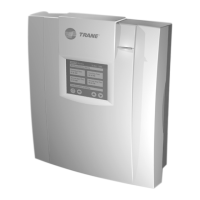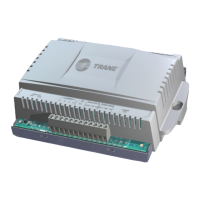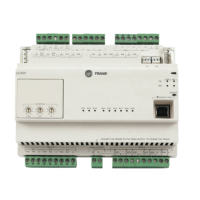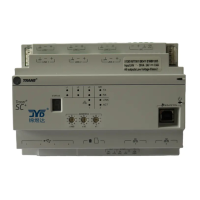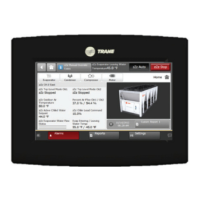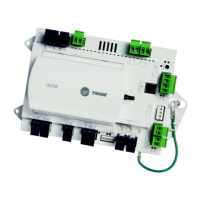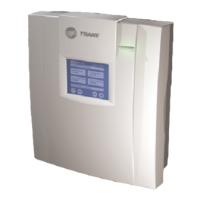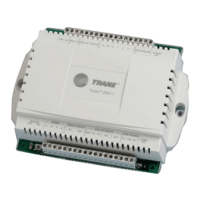Examples of network variable bindings
CNT-SVP01C-EN 119
Figure 76. Comm5 network for example 1
Use the Rover service tool to create bindings. (See the Rover Operation
and Programming guide, EMTX-SVX01C-EN.) Using the Rover service
tool, select the network variable from the Tracer MP503 and then select
the Tracer MP581. The Rover service tool shows you only the variables in
the Tracer MP581 of the SNVT that matches the variable you selected in
the Tracer MP503.
Table 14 shows the bindings needed.
Once you have completed the bindings, program the Tracer MP581 to dis-
play this data on the operator display. Remember that the outside air
humidity is being transmitted over the network in units of mA. Some cus-
tom programming is required in the Tracer MP581 to convert the humid-
ity from units of mA to units of percent (%). Custom programming in the
Tracer MP581 will also use the outside air temperature and humidity to
calculate the outside air enthalpy and use it to control the economizer of
the AHU. See Figure 77 on page 120 for a sample program written in the
TGP editor.
Table 14. Bindings for example 1
Network variable output on the
Tracer MP503
Network variable input on
the Tracer MP581
nvoTemperature1 binds to
nviTemp01
1
nvoCurrent2 binds to
nviCurrent_mA01
2
nvoBIP3Status binds to
nviSwitch01
3
nvoBIP4Status binds to
nviSwitch01
3
1
The Tracer MP581 has 40 generic temperature (SNVT_temp_p) network variable
inputs available for binding (nviTemp01 through nviTemp40).
2
The Tracer MP581 has 8 generic current (SNVT_amp_mil) network variable inputs
available for binding (nviCurrent_mA01 through nviCurrent_mA08).
3
The Tracer MP581 has 40 generic binary (SNVT_switch) network variable inputs
available for binding (nviSwitch01 through nviSwitch40).
Comm5 link
Tracer MP503
Tracer MP581 with
operator display
Additional
LonTalk
devices
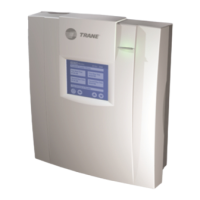
